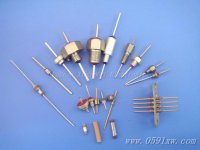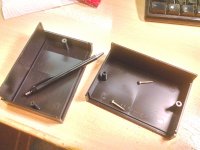I am looking to shield the top and bottom of some enclosures I have in order to block any interference. The sides are aluminum, so it would only be some square and rectangle areas ranging from 4"x4" to 6"x10".
Would paint over foil be a good choice? I notice many sellers of foil on ebay etc, and feel the foil is cheaper than paint. Any concerns with the chemical compounds used in the paints? Thanks in advance.
Would paint over foil be a good choice? I notice many sellers of foil on ebay etc, and feel the foil is cheaper than paint. Any concerns with the chemical compounds used in the paints? Thanks in advance.
research why tin foil always protect against interference
https://www.google.com/search?q=tin...hUKEwjzgLK-mbnMAhXPZj4KHcQYBHwQsAQIGw#imgrc=_
https://www.google.com/search?q=tin...hUKEwjzgLK-mbnMAhXPZj4KHcQYBHwQsAQIGw#imgrc=_
How will you join the foil or paint to the aluminium sides?
Overlap... the aluminum and the shielded piece only need contact, no?
Unless you filter ALL of the lines going in or out of your shielding there will be interference carried in on the lines. ( if the interference is along conducted paths) See jpg for example of single line filters for shielded enclosures.
But first:
What frequency of interference?
Is it electric field or magnetic field?
What (or how) is the interference showing up?
It is sometimes easier to put a small amount of filtering on the lines that are susceptible to interference rather than shielding the entire circuit.
But first:
What frequency of interference?
Is it electric field or magnetic field?
What (or how) is the interference showing up?
It is sometimes easier to put a small amount of filtering on the lines that are susceptible to interference rather than shielding the entire circuit.
Attachments
Overlap... the aluminum and the shielded piece only need contact, no?
Aluminum (unless correctly treated) oxidizes very quickly. Aluminum oxide is an insulator. This is why you will see star washers under bolt heads or nuts to break the oxide layer to make a connection. On the plus side this oxide layer is very thin so connecting to it is not too much of a problem.
You will have to decide how many connection points will be needed for your shielding. This depends on the frequency and level of shielding you need.
you must identify a problem before you can solve it otherwise 'any road will take you there'
Copper Foil Tapes
I haven't used these tapes but they cost seems more reasonable. cheap adhesives after soldering along edges may present a problem. thicker copper > 3mils is needed for strong AM broadcast signals
Copper Foil Tapes
I haven't used these tapes but they cost seems more reasonable. cheap adhesives after soldering along edges may present a problem. thicker copper > 3mils is needed for strong AM broadcast signals
Last edited:
I have used copper foil and sputtered metallic paint in production. Both are a pain to connect to aluminium. Often it is easier and cheaper overall to have a concealed metal box inside a plastic cosmetic casing
A piece of copper clad pc board can be used as a shield, as long as connection is made to the copper in some fashion.
Not really...
shielding is ALL about seams and slots...
I second Davidsrsbs' comments, shielding effectively is not easy and as others have stated unless your lines are filtered you will have conducted immunity problems.... (noise picked up by leads).
shielding is ALL about seams and slots...
I second Davidsrsbs' comments, shielding effectively is not easy and as others have stated unless your lines are filtered you will have conducted immunity problems.... (noise picked up by leads).
Well, we do it in various guitar amps, the input stages are very sensitive, and a grounded copper plane right over that portion of the board cuts down noise tremendously. The later stages and phase inverters do not need such shielding.
For an example, scroll down to the second image at this URL, the lower left quadrant is a pc board shield over the high gain circuits.
Peavey Triumph 60 mods | Iskrem Electro
For an example, scroll down to the second image at this URL, the lower left quadrant is a pc board shield over the high gain circuits.
Peavey Triumph 60 mods | Iskrem Electro
I've used kitchen grade aluminum foil glued to plastic or wood for decades, with excellent results.
Don't overthink the aluminum natural oxide surface, it's atoms thick and never stops contact.
IF you want it to be insulating there is a special anodizing related process which can grow a thick one, otherwise the natural process creates very thin ones, which with the lightest pressure break and allow conduction.
Don't overthink the aluminum natural oxide surface, it's atoms thick and never stops contact.
IF you want it to be insulating there is a special anodizing related process which can grow a thick one, otherwise the natural process creates very thin ones, which with the lightest pressure break and allow conduction.
line level audio is fairly immune to RF interference esp if reasonable building practices are observed like using HF bypasses near ICs / active parts, short interconnects and/or twisted pairs. So rather than shielding the whole product, identify sub circuits that need special attention E.g low level, high gain and enclose them in an small inexpensive bud box or even a used mint tin /cookie container. Tin plated steel is actually superior because it shields both H and E fields and aluminum foil doesn't. Pro audio typically goes into broadcast studios with RF nearby so they use ferrite beads and small ceramic bypass at all entry points E.g. lossy 2 pole LPF at ~200KHz.
Last edited:
The average western home is full of RF these days, a studio especially if it is near the rf broadcast will more than likely be shielded....
As to immunity, home brew kit tends to exclude the EMC components.....
Pro stuff does tend to have EMC protection...
As to immunity, home brew kit tends to exclude the EMC components.....
Pro stuff does tend to have EMC protection...
By far the strongest RF signals most equipment has to deal with are nearby cellphones and WiFiThe average western home is full of RF these days, a studio especially if it is near the rf broadcast will more than likely be shielded....
As to immunity, home brew kit tends to exclude the EMC components.....
Pro stuff does tend to have EMC protection...
Radio amateurs are a more unusual hazard these days
Not on about Ham Radio, it was a reference to:
🙂Pro audio typically goes into broadcast studios with RF nearby so they use ferrite beads and small ceramic bypass at all entry points E.g. lossy 2 pole LPF at ~200KHz.
Hi all ! I was about to start a new thread but diyaudio automatically suggested this one, so here is my problem. For years I've been using shielding in equipment, more as a recipe or as prevention but never knowing much about the details. I know the theory. Now, I need to be sure that a low level magnetic cartridge preamp input stage is properly shielded from EMI, transformers fields, RF, etc. The device I designed is very simple but uses a small, inexpensive plastic case. I would like to use this copper foil .
I took an old piece of copper strip of about 0.5 mm thickness and placed on one side a powerful piece of magnet (from an old hard disk drive) and a metallic washer on the other. To my surprise (and perhaps because of my ignorance on this subject) the washer was effectively attracted by the magnet and remained stuck to the copper strip. I changed the magnet for a much smaller one with same results !
So my question is: how does copper and aluminum shielding works ? Are there different shielding grades ? If I shield my plastic box from the inside and taking care of electrically connecting all planes by soldering or with cables to signal ground, would I be really shielding my sensitive circuit ?
I would like to hear from the experts. Thank you in advance.
I took an old piece of copper strip of about 0.5 mm thickness and placed on one side a powerful piece of magnet (from an old hard disk drive) and a metallic washer on the other. To my surprise (and perhaps because of my ignorance on this subject) the washer was effectively attracted by the magnet and remained stuck to the copper strip. I changed the magnet for a much smaller one with same results !
So my question is: how does copper and aluminum shielding works ? Are there different shielding grades ? If I shield my plastic box from the inside and taking care of electrically connecting all planes by soldering or with cables to signal ground, would I be really shielding my sensitive circuit ?
I would like to hear from the experts. Thank you in advance.
Attachments
conductive metal shielding only works on AC magnetic fields
and even then the required thickness becomes expensive by 50/60 Hz
but at MHz just about any foil works
Skin depth in copper
Frequency Skin depth (μm)
50 Hz 9220
60 Hz 8420
10 kHz 652
100 kHz 206
1 MHz 65.2
10 MHz 20.6
100 MHz 6.52
1 GHz 2.06
you realy want several skin depths (3+) at the interference frequency for the induced Eddy currents to effectively shield (reflect) AC magnetic fields
for low frequency magnetic fields you can use soft iron or low carbon steel to cheaply 'short out' the mag field with a box with small holes
and even then the required thickness becomes expensive by 50/60 Hz
but at MHz just about any foil works
Skin depth in copper
Frequency Skin depth (μm)
50 Hz 9220
60 Hz 8420
10 kHz 652
100 kHz 206
1 MHz 65.2
10 MHz 20.6
100 MHz 6.52
1 GHz 2.06
you realy want several skin depths (3+) at the interference frequency for the induced Eddy currents to effectively shield (reflect) AC magnetic fields
for low frequency magnetic fields you can use soft iron or low carbon steel to cheaply 'short out' the mag field with a box with small holes
Last edited:
OK jcx, thank you. So in the first place it is normal that a permanent magnet trespasses a single layer of copper (or aluminum). In the case of AC 50 or 60 Hz , a single foil like the tape I showed before should attenuate a near power transformer field or RFI ? SHould I cover completely the internal surfaces of my plastic enclosure ? Is flat foil same as round shielding eg: a cable shield like microphone cable ? I just want to have a solid yet simple method to efficiently isolate 50/60 Hz magnetic fields and/or RFI. How do I do that using auto adhesive copper foil ?
- Status
- Not open for further replies.
- Home
- Design & Build
- Parts
- Shielding Plastic - Paint or Foil?

